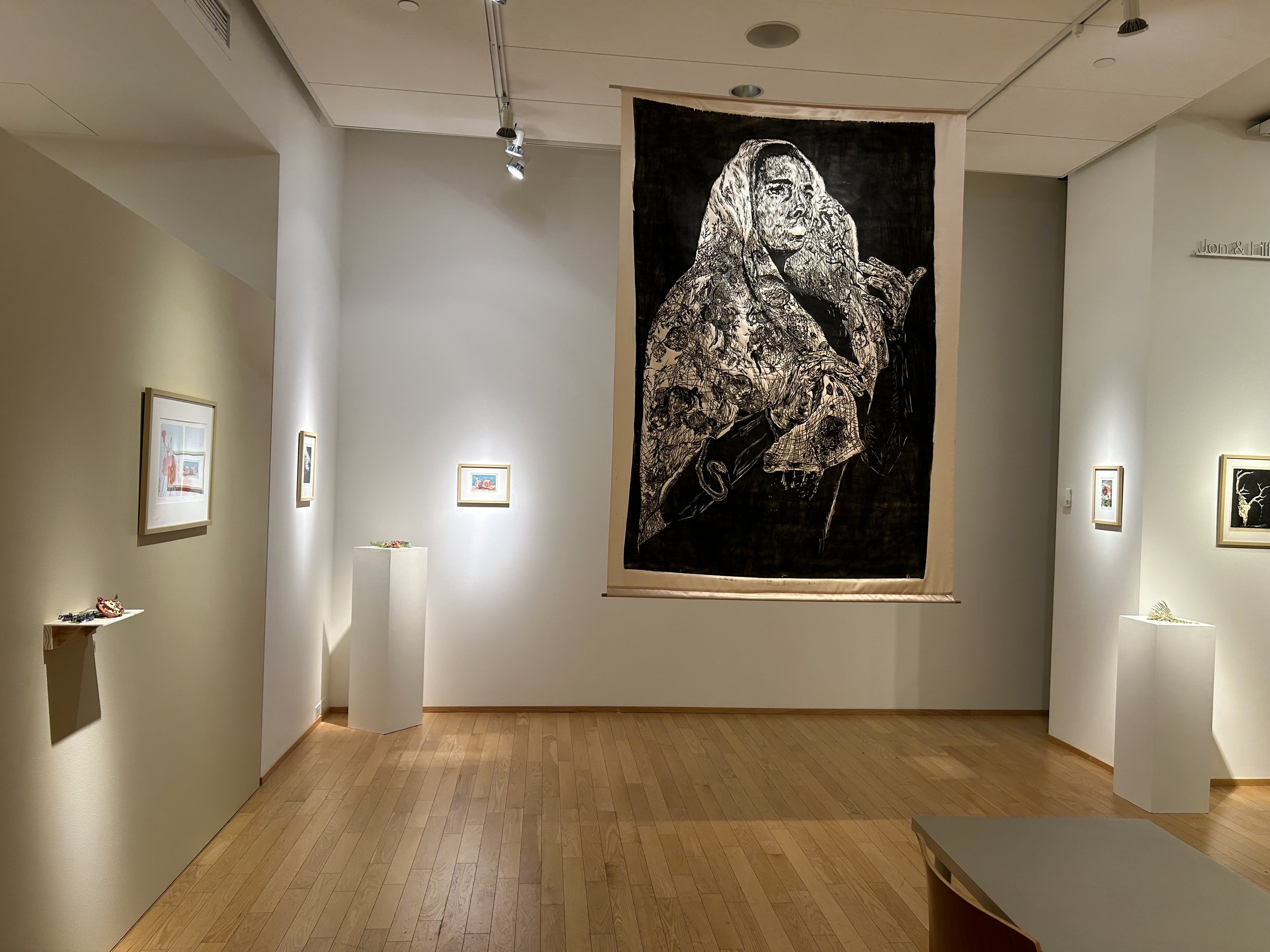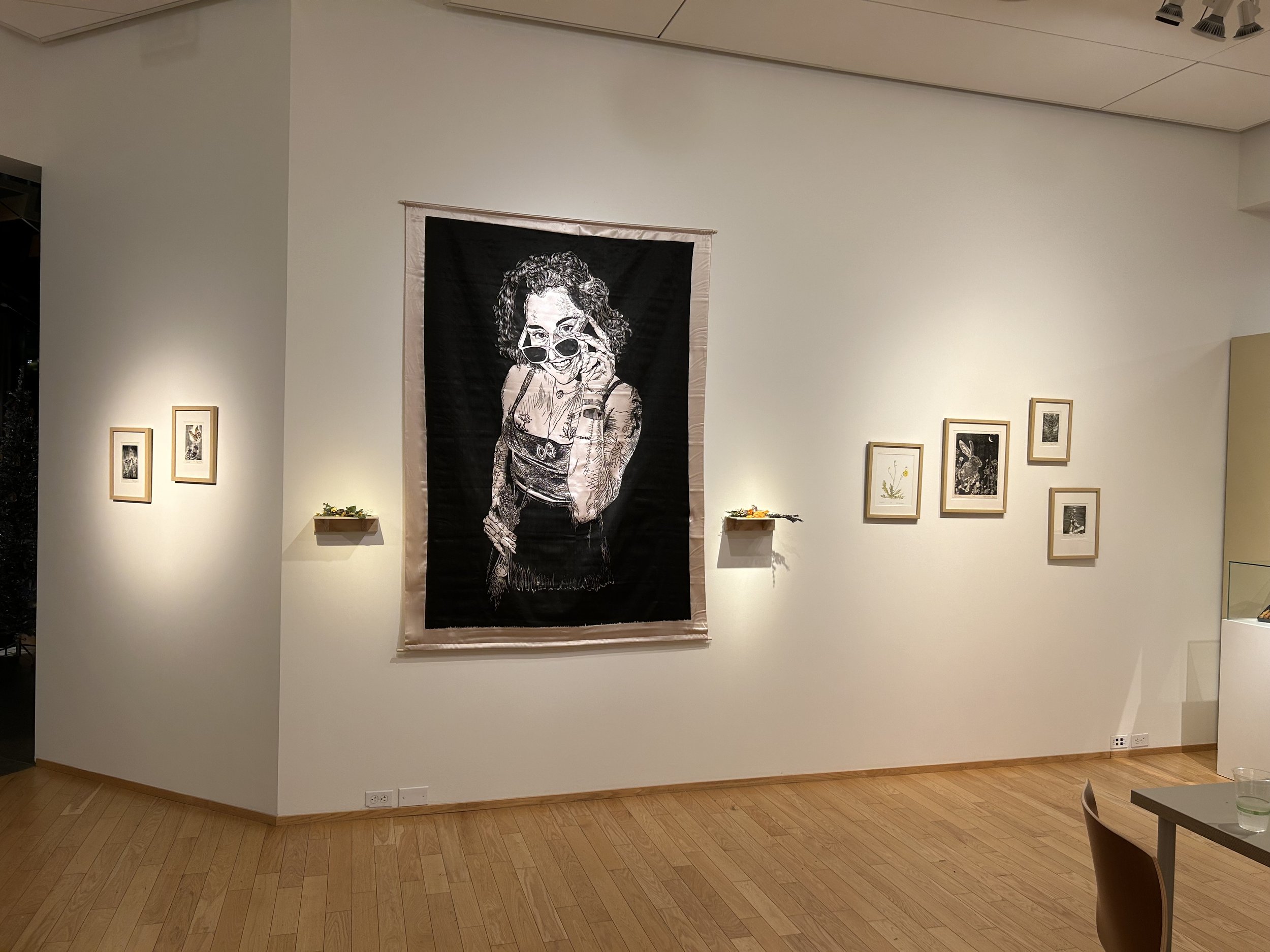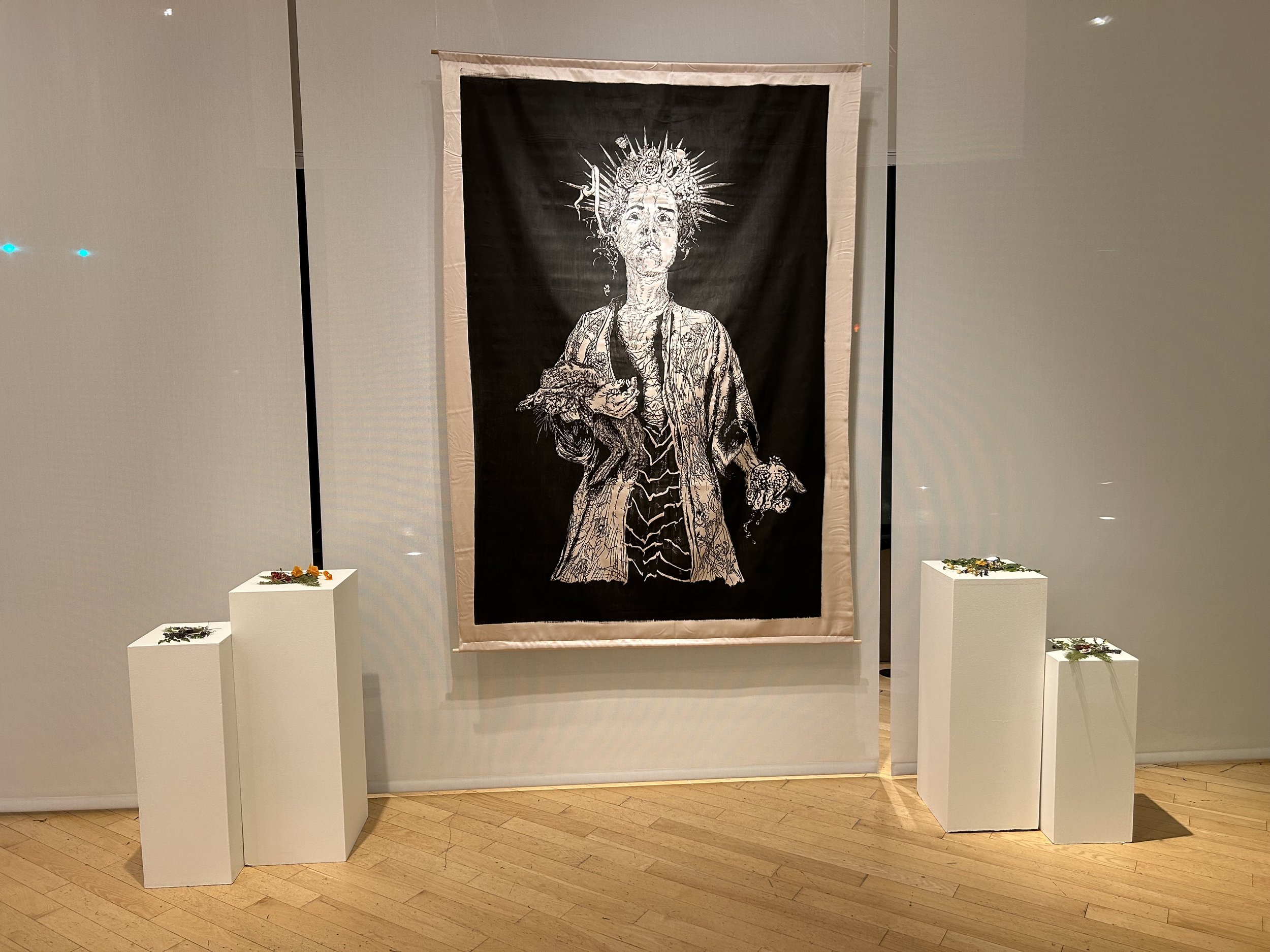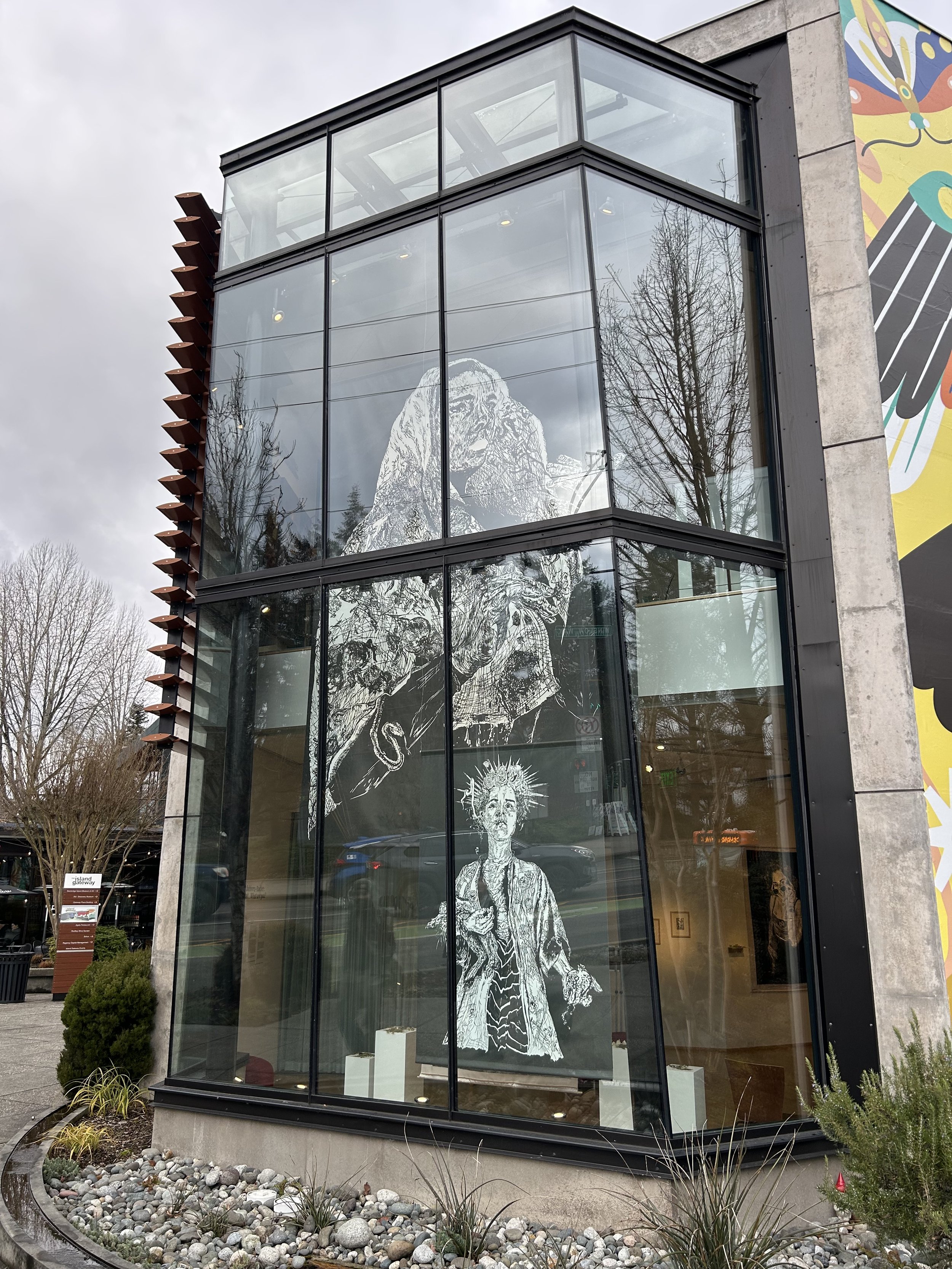Shahrazad
Woodcut on fabric
2022
6 x 4 feet (image)
For sale, please inquire
Printed on fabric like tattoos on skin, symbols that represent my heritage, alongside Greek mythology, queer culture, and pop culture cover my woodblock self-portraits. With this storytelling, I seek to remove the passive acceptance of accessible exoticism and redefine being a mixed race woman who is white-adjacent. I uplift and add to the collective story of thousands of women’s voices that came before mine - many that were silent or silenced throughout history and today. I seek to shift the implied heteronormative male gaze out of my work and widen the viewfinder to include my life’s intersections of gender, race, and sexuality.
Persephone
Woodcut on fabric
2022
6 x 4 feet (image)
For sale, please inquire
Wait… What are you?
In the “Wait…what are you?” series (a question all too familiar to mixed race people), I am making sense of why I hate the word ‘exotic’ and resented the experience of being a woman for a good portion of my life. I re-examine female characters from stories I passively internalized in childhood through my gay, mixed race lens. These womens’ individual voices and feelings were not included in the stories I heard growing up –only the actions of others in positions of power over them. In this series, I undertake giving their perspectives (and my own) authority.
Medusa
Woodcut on fabric
2022
6 x 4 feet (image)
For sale, please inquire
I began my series with Shahrazad, who is looking directly at the ‘male gaze’ and using the tools she has to stay alive. Her cleverness in storytelling is often exalted, but I wanted to draw attention to what she didn’t get to say living in fear of death every night. Next, I worked with Medusa. She could not overcome the violence of men and bears the burden of its consequences forever in her body. Third, is Persephone who suffered death, but also used it by accepting it into her seasonal shifts through life, becoming Queen of the Underworld. Finally, I reimagined Barbie. My gay femme icon who helped me understand my true self as a gay woman in my childhood. She is choice and celebration of being in her own power and community.
Barbie
Woodcut on fabric
2022
6 x 4 feet (image)
For sale, please inquire
Artist Bio
Nikki Jabbora - Barber (she/her), a gay Seattle-based printmaker and teaching artist, was born in Bellingham, WA to a Lebanese-German mother and Anglo-Swedish father. Her work focuses on her mixed race identity, centuries of storytelling, and womanhood through symbolic depictions of herself, flora, and fauna.
Nikki regularly leads community engagement projects, including with the Seattle Art Museum. Nikki balances making and selling her hand-pulled fine art prints; photographing works on paper for Davidson Galleries; and teaching community art classes at Pratt Fine Arts, Pilchuck Glass School, Coyote Central, and others in Seattle, WA.
“…speak what I need to speak through my artwork and it usually takes up more space than I ever could verbally.”
— Nikki, Interview with Valerie Peterman





Nikki Jabbora-Barber: Wait…What are you?
Review by Paige McCray
Artist: Nikki Jabbora-Barber (she/her)
Exhibition: Wait…What are you?
Location: Bainbridge Island Museum of Art, Lovelace and Beacon Window Galleries
Dates: Nov 23, 2024 – Feb 23, 2025Artist talk: Feb 8, 2025 3:00pm – 5:00pm
Nikki Jabbora-Barber: Wait…What are you?
Review by Paige McCray
Nikki Jabbora-Barber presents the soft power of knowing oneself, living as oneself, and creating oneself through striking woodcuts. Her exhibition Wait…What are you? at the Bainbridge Island Museum of Art feels like a personal cathedral of icons, imposing figures, offerings, places for reflection, corners for confession.
The central focus is her newest series, also titled “Wait…What are you?”, made up of large-scale woodcuts of the artist as Shahrazad, Medusa, Persephone, and Barbie, printed on fabric. They hang around the space like decorative tapestries, or official portraits of leaders and royalty, or memorials to martyred saints. These pieces dominate the space and set the tone. Dark black ink highlights the shining fabric. Faces look out from above. There is exaltation and consideration; pain, pride, and power.
These are the elements that Jabbora-Barber draws from, and the world in which her work resides — in the space between dark and light, life and death, ancient mythology and the hyper-contemporary, the purely organic and the obscenely plastic.
It is the natural world that we meet first. The exhibition space is populated with groupings of smaller woodcuts and fruits and flowers preserved in resin atop shelves and pedestals. These corners and clusters provide entry points to get closer to the work, to examine the textures of the plants that inspired the woodcuts. Jabbora-Barber’s work has long included depictions of Northwest flora and fauna, and they make important thematic contributions here as well.
In these intimate pieces, we begin to understand the closeness of life and death, a concept that touches many of these works. Starting with dried pomegranates, dandelions, pansies, and ferns, there is a breaking of boundaries. The plants are dead, but frozen as if alive. They might be offerings to spirits or gods. Or a botanist’s specimens. Or ingredients for naturopathic medicines. Maybe they died to treat the living.
If we imagine they are offerings, they represent a bridge between the worlds of the living and the dead; items that can pass through an invisible barrier and reach the unreachable. They bend the rules of space and time to make the past and present much closer. The pomegranates, for example, exist in the exhibition as real, physical objects and as images in the color woodcut ‘Pomegranate’, in the colorless ‘Squishing Pomegranates (Persephone’s Pomegranates)’ and in the large-scale ‘Persephone’. The physical, material world becomes closer to the pictorial world. A dialogue continues, passing back and forth between the objects before us.
The pomegranate is a symbol of vitality, sexuality, and a cultural reference to the MENAP region of the artist’s personal background. In ‘Pomegranate’ the fruit stands alone, with the seeds and pith exposed on one section, consumed with color inside and out, and not the expected rich reds but mostly blue, green and yellow. The pomegranate in ‘Squishing Pomegranates (Persephone’s Pomegranates)’ is rendered completely in black but appears equally as vibrant. Cut in half, it fits perfectly into the palm that holds and squeezes it with the ring and middle fingers, with juice dripping down. The action is offered to us with a hint of performance, a sexual provocation. This gesture is repeated in ‘Persephone’. Although the pomegranate kept Persephone trapped in Hell, it is repurposed in Jabbora-Barber’s hands, offering an alternative from a queer viewpoint.
‘Persephone’ also shares the symbol of the rabbit with ‘White Rabbit’. The rabbit is alive in ‘White Rabbit’ and dead in the arms of Persephone. When living, it stands against a dark night sky and looks at the viewer with a keen eye. Its finely textured fur connects it to the thistles, flowers and foliage around it. The animal’s confident gaze reflects a wisdom and attention that matches the direct gaze of Persephone. In ‘Persephone’, however, the rabbit has died. While referencing Joseph Beuys’s 1965 performance, ‘How to Explain Pictures to a Dead Hare’, Jabbora-Barber uses the rabbit to speak on the Resurrection and more broadly, rebirth and the knowledge of natural beings. Even in death, the rabbit plays an active role, offering its natural intelligence to Persephone.
After entering and developing the world of life, death, and the unsteady middle, Jabbora-Barber returns to the foundational question: What are you? By selecting this title for the exhibition, she reclaims power and revokes the inquisitor’s hostility. She begins in an uneasy position, on the back foot, under a hostile gaze. But she turns the situation around completely. And while she has every right to be defensive and deny this act of othering, she responds with honesty. She refuses to give any answer that would be satisfyingly simple and would allow the inquisitor to enjoy the exoticism they attempt to ascribe. She breaks open the question to reveal dozens more: dozens of assumptions, conditions, and desires.
‘Medusa’ is a logical entry to the answers. She is perhaps the most well-known figure, bearing layers and layers of assumptions and accusations. The forgotten or omitted details of her story make it ripe for reinterpretation. Medusa is fierce, feared. She deflects the desire of the male gaze, the white gaze, with snakes and armor. Jabbora-Barber’s ‘Medusa’ is naked but doesn’t appear exposed. Flowers are tattooed on her skin and the woodcut’s texture creates designs that focus on the creation instead of presentation. There is no unlimited access. Medusa’s snakes are awake, alive, and another reminder that no look is without its price.
All of the works in this series are self-portraits. By placing herself in the work, Jabbora-Barber not only creates ‘Medusa’, she is Medusa. She takes a risk by exposing herself but gains the power to present herself on her own terms. So although Jabbora-Barber is partially answering the questions of her interrogators, she is doing it herself, and only offering what she chooses. Who has the power to insert themselves into these legends? Someone who understands that they have always been a part of them. Someone who understands the stories well enough to tell them with their bodies. Who is willing to display themselves at this scale, and to do it four times? To be this vulnerable? Someone who is used to being watched, seen, and questioned. Someone who knows how to show strength while under scrutiny.
‘Persephone’ is another powerful answer to what or who the artist is. A queen and a goddess, her image hangs freely in the space, truly presented as an icon to bow before. With the pomegranate in one hand and rabbit in the other, the focus is on her regal face and crown. Strikingly composed, her crown is not just beautiful. Like Medusa, Persephone carries a snake on her head, not as hair but in the crown. A ruler, a victim, a survivor, the power she radiates is complex.
‘Shahrazad’ is the first created in the series, and it too hangs freely, confrontationally in the space. She emerges from a penetrating black, but the shimmering fabric peeks through, allowing her clothing to shine. Rich with patterns, her clothing covers her skin but reveals her heritage, reflecting Jabbora-Barber’s experience of being unable to hide her own brown skin and choosing to embrace its meaning.
‘Barbie’ appears somewhat surprisingly. Another complication to unsettle anyone seeking a simple answer to the “What are you?” question. The references are difficult to place because they don’t come from just one tradition. Not just Catholic and Western, not just antiquity. Also Middle Eastern, also Native, natural, and Northwestern. Also queer and alternative. Her answers involve several clauses. To deny one is to get the whole answer wrong.
Jabbora-Barber’s ‘Barbie’ has the signature sunglasses, a big smile, feminine/pretty/doll-like traits. But she also bears the artist’s tattoos, including snakes and again, the rabbit. She wears a pomegranate necklace. She holds a hyacinth to reference her native homeland, Lebanon/Syria, and lavender, to reference sapphic love. Her bracelet displays the inverted triangle reclaimed by the LGBTQ community. Her symbols are layered, but the prevailing effect is joy. All of these intertwined modes and meanings are connected by an internal power. A fearlessness that can come only from a rare knowledge and certainty of oneself, and embracing each element of who you are.
So, what are you? Jabbora-Barber responds with something like: I am the past. I am the Middle Eastern survivor, Shahrazad. I am right now. I am a plastic Barbie and a descendant of AIDS activists. When I am naked and exposed, I am the dangerous Medusa. I am not good or evil. I don’t live exclusively in Heaven or Hell; I am Persephone.
The reality of who we are is as complex as Jabbora-Barber makes it seem. If you want to know me, you need to know those who came before me. You need to know what I’ve been through and who I choose to be now. We come from antiquity, we come from pop culture. We are made from plastic molds and marble stones. We continuously make ourselves, for ourselves.




